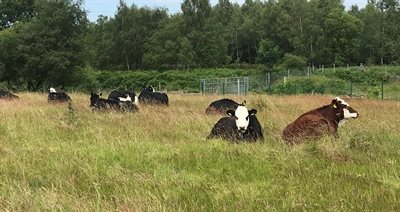Posted on Wednesday 20th March 2024

Cattle grazing in Moors Gorse on Cannock Chase as part of Staffordshire County Council's conservation grazing scheme.
Cattle will return to Cannock Chase this month, as part of a project to restore heathland habitats in an environmentally friendly way.
Up to 15 native cattle will graze 25 hectares at Moors Gorse from next week until the end of summer.
This is the fourth year of Staffordshire County Council’s conservation grazing scheme, which plays an important role in restoring heathland habitats that rare species rely on.
Staffordshire County Council’s Head of Environment and Countryside, Sarah Bentley, said:
“Conservation grazing is a really important tool to look after Cannock Chase’s internationally important area of rare heathland habitat.
“Heathland is rarer than rainforest and, nationally, we have lost over 80% since 1800, leaving many wildlife species facing an uncertain future.
“Grazing with cattle is a recognised sustainable way of helping flowering plants to grow for pollinators, preventing scrubland and small trees from growing out of control and creating bare ground in small areas, which will be used by rare invertebrates.”
The grazing cattle will be a mix of native breeds, consisting of belted Galloways, Highlands and Herefords.
These breeds are best for conservation grazing because they are hardy, calm and better adapted to eat the range of plants found in our natural environment just like the wild cattle and ponies that once roamed the country.
A perimeter fence has been erected, which has been designed to allow other animals such as deer to pass through but keep the cattle within.
Sarah Bentley continued:
“These cows are used to people walking through their fields, but I urge passers-by to please keep a respectful distance.
“I also want to remind people walking their dogs through Cannock Chase to pick up after your pets as their mess can carry disease that is dangerous to wildlife and livestock. Also, please stick to paths and keep dogs under control to not disturb adders, ground-nesting birds and other animals.”
Conservation grazing at Moors Gorse was first piloted by Staffordshire County Council in 2021 after seeing success with grazing habitats at Chasewater Country Park and Hednesford Hills over many years.
Staffordshire County Council has a statutory responsibility for the 1,300 hectares of Cannock Chase Country Park and the 26 square mile National Landscape that it lies within. It contains plants and species of such national and international importance that it is also listed as both a Special Area of Conservation and a Site of Special Scientific Interest.
The county council developed a Natural Environment Strategy to enhance support for wildlife, biodiversity and Staffordshire’s wider natural environment, which was approved by cabinet members at the start of this year.